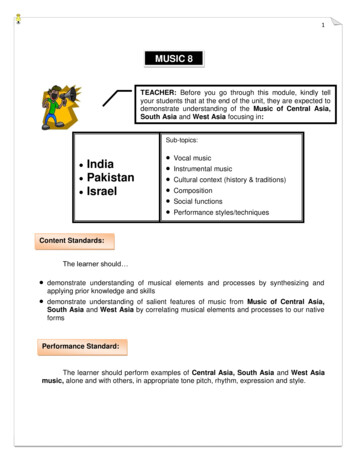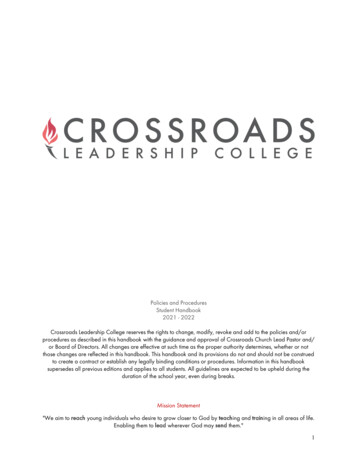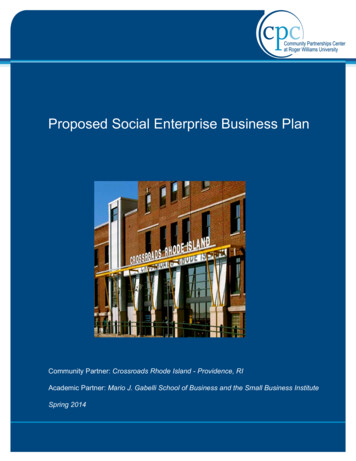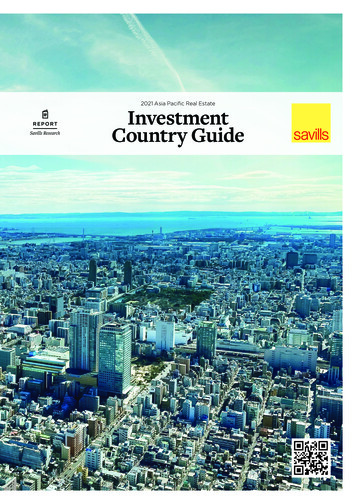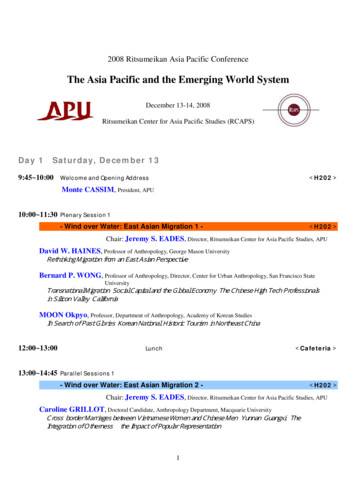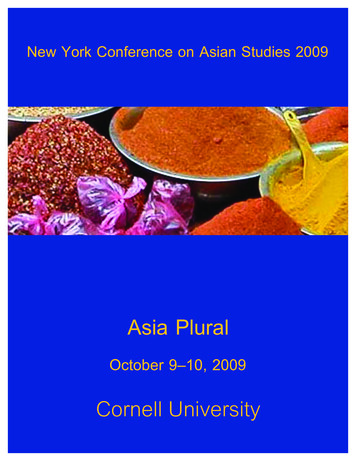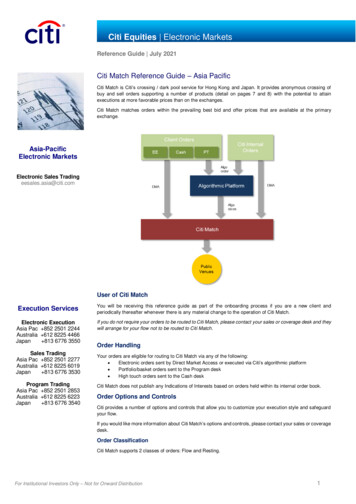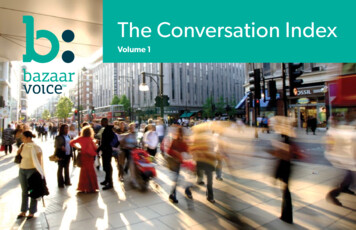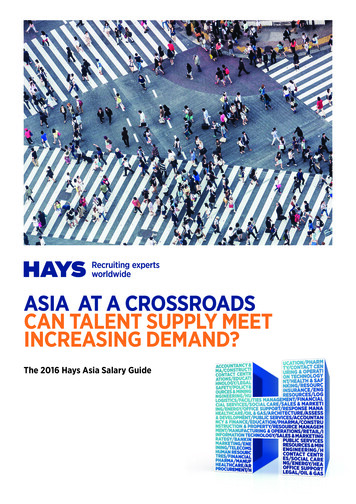
Transcription
ASIA AT A CROSSROADSCAN TALENT SUPPLY MEETINCREASING DEMAND?The 2016 Hays Asia Salary Guide
CONTENTSIntroduction3Market Overview & Trends4Salary Policy6Recruitment Trends9Economic Outlook15Candidate Trends16Salary Information21Accountancy & Finance22Architecture32Banking & Financial Services34Construction & Engineering44Contact Centres48Education49Finance Technology50Human Resources59Information Technology63Insurance71Legal76Life Sciences79Manufacturing & Operations83Office Professionals91Oil & Gas94Procurement99Property101Sales & Marketing104Supply Chain108
WEATHERING CONDITIONSADAPTING STRATEGIESWelcome to our 2016 Hays AsiaSalary Guide. The salary andhiring insights in this ninthedition of our annual Guide aredrawn from over 3,000employers across Asiarepresenting some six millionemployees. As economicconditions continue to change inAsia, our Guide providesvaluable information to helpboth employers and candidatesplan for the year ahead.Most employers surveyed are expecting skillsshortages to challenge efficient operations in theyear ahead but overall we still expect employers totake a cautious approach to salary increases over thenext 12 months. At the same time, our researchshows salary expectations among candidates arehigher than last year. Candidates will need to dotheir research carefully when moving roles orapproaching their current employer about a pay riseto ensure they have realistic expectations.We hope the salary and recruitment market insightscontained here will help to inform effectivestrategies for the year ahead.We look forward to working with you soon.Christine Wright – Managing Director, AsiaFor employers the message is to focus attention onstaff retention strategies as our candidate surveyreveals a high level of candidates are either activelylooking for a new role or open to hearing about anew opportunity. The Guide provides insight into thebenefits candidates value most highly and notes thatthese differ when candidates are asked what keepsthem in a job versus what they look for in a new job.Thank youWe would like to express our gratitude to all those organisations who participated in the collection of data for this year’sGuide. Your contribution has ensured that we can produce an informative publication to help support your business decisions.Disclaimer: The Hays Salary Guide is representative of a value added service to our clients and candidates. Whilst every care is taken in the collection andcompilation of data, the guide is interpretive and indicative, not conclusive. Therefore information should be used as a guideline only and should not bereproduced in total or by section without written permission from Hays.
MARKET OVERVIEW & TRENDS60%OF EMPLOYERS ENVISAGEBUSINESS ACTIVITY TO INCREASEIN THE NEXT 12 MONTHS
CAUTIOUS MARKETS & SKILLS SHORTAGESA CHALLENGING 2016We expect a challenging year aheadfor employers with many cautious aboutsalary increases but also worried aboutskill shortages.Of the employers surveyed, 96 per cent said skillsshortages have the potential to hamper effectiveoperations and 34 per cent said that they don’t havethe talent now to achieve current business objectives.Areas of shortage include entry and middle managementaccountancy and finance staff, middle managementengineering, IT, marketing, operations and HR talent andentry-mid level sales roles. To manage shortages, 65 percent of employers would consider employing or sponsoringa qualified overseas/expatriate candidate.The employer survey revealed 43 per cent of employersplan to increase permanent headcount over the next12 months, while 46 per cent expect staff levels to remainunchanged. On the other hand, 60 per cent of employersused a flexible staffing approach in the past 12 months,(up six per cent on the previous year). The most popularapproach is the use of temporary workers or contractorsthrough a recruitment agency, and 19 per cent expect toincrease their use of temporary staff in the year ahead.On the candidate side, our survey research shows manycandidates are restless with 44 per cent actively looking for ajob and 42 per cent open to hearing about a new opportunity.A quarter of candidates surveyed anticipate moving jobswithin the next six months and 21 per cent within a year.Reasons for job hunting include better salary and benefits(48 per cent), new challenges (40 per cent), lack ofcareer progression in their current role (36 per cent) andmanagement style/company culture (25 per cent).A sizeable 62 per cent of candidates did not ask for a payrise in the last 12 months but our research reveals that 46per cent are looking for an increase of more than six percent in the coming year. This could create tension as despiteskills shortages, only 28 per cent of employers are planningto award increases of more than six per cent this year.China leads the salary field with 60 per cent of employersexpecting to increase salaries by more than six per centin the next 12 months. Conversely in Japan 63 percentof employers expect to increase salaries by only up tothree per cent. In Hong Kong, Singapore and Malaysia themajority of employers intend to increase salaries betweenthree and six per cent.the employers surveyed, 43 per cent expect their localeconomy to weaken in the coming 12 months, (25 per centhigher than last year), and 42 per cent expect no changein current conditions. Only 15 per cent expect strongereconomic conditions.Last year 72 per cent of employers expected an increasein their business activities in the next 12 months but in ourlatest survey only 60 per cent are making a similar forecast.With employers cautious about salary increases, retentionstrategies should come into focus over the next yearparticularly in light of our research showing a high level ofcandidates either actively or passively looking for a new job.According to our candidate survey the main reasonsemployees stay with a current employer are work-lifebalance (45 per cent), salary and benefits (40 per cent),career progression (37 per cent) and job security(33 per cent). On a country level, work-life balance is themain reason people stay with an employer in Hong Kong,Singapore and China. In Japan career progression is thekey to retention while in Malaysia it’s salary.The fact work-life balance rated so strongly withcandidates provides valuable insight for organisationsreviewing staff retention strategies. Only 17 per cent of thecandidates we surveyed rate their current work-life balanceas “very good”, while 38 per cent describe it as “good” and31 per cent as “average”.On the plus side, 60 per cent of candidates believe theircurrent organisation offers scope for career progression –another major reason employees stay in a job.To find the right talent organisations will also need to focusgreater energy on the diversity of their workforce.Our research reveals only 51 per cent of employers haveformal diversity policies and practices in place. Of these,just 20 per cent say their policies are adhered to well and34 per cent fairly well.Looking at the five countries included in the Guide,29 per cent of management roles overall are held bywomen which is unchanged since last year, and 16 percent of employees are foreign. Comparing countries,Singapore’s workforce is the most diverse with 28 per centof roles held by foreign employees, followed by Hong Kongwith 18 per cent. China’s is the least diverse with only eightper cent of roles held by foreign employees. This is echoedin the 2015 Hays Global Skills Index where China wasscored as having a highly inflexible labour market mostlydue to its tight legal and regulatory environment.We advise candidates to be realistic in their salaryexpectations and consider the business climate. OfView our findings on the degree to which employers havedifficulty recruiting skilled labour across the globe in theHays Global Skills Index 2015.hays-index.com
SALARY POLICYSALARY INCREASES1. Average % increases from last reviews across all countries:10%23%40% 20% 7%NilUp to 3%From 3% to 6%From 6% to 10%More than 10%By country:NilChina 8Hong Kong 8From3% to 6%Japan 13Singapore 1281182450511512144186112Morethan 10%135716Malaysia 6From6% to 10%50236Up to 3%MARKET OVERVIEW & TRENDS: SALARY POLICY2. Intended average % increases for next reviews across all countries:7%26% 39% 20% 8%NilUp to 3%From 3% to 6%From 6% to 10%More than 10%By country:NilChina 4Hong Kong 7Malaysia 4Singapore 76 2016 Hays Salary Guide - Asia611221810294628Morethan 10%166311From6% to 10%5719Japan 15From3% to 6%44297Up to 3%47117
SALARY POLICYBENEFITS3. Do you give benefits in addition to salary and bonus?84% 16%YesNoIf yes, which of the following are provided?*Across all fe assuranceCar/car lub/gymmembershipHardship allowanceTax equalisationChildren’s education7%Private expenses*More than one may be applicable.2016 Hays Salary Guide - Asia 7
SALARY POLICYBONUSES4. Do bonuses form part of your organisation’s remuneration package?63% 27%10%Yes for all staffNoYes, but only forsome staff5. What percentage of staff will be awarded bonuses this year?MARKET OVERVIEW & TRENDS: SALARY POLICY & RECRUITMENT TRENDS 11%15%12%11%51%NilUp to 10%From 10%to 20%From 20%to 50%More than 50%6. Are bonuses related ormanceTeamperformanceGuaranteedHours billed*More than one may be applicable.7. What percentage of staff salary will be awarded as a bonus? 33%44%13%10%Up to 10%From 11%to 50%From 51%to 99%100%8 2016 Hays Salary Guide - Asia
RECRUITMENT TRENDSSTAFFING8. Over the last 12 months, have permanent staff levels in your department.19%Decreased38%Remainedthe same43%Increased9. In the next 12 months, do you expect permanent staff levels in your department to.11%Decrease46%Remainthe same43%Increase10. In the last 12 months, have you used a flexible staffing approach?60% 40%YesNoIf yes, please specify which one is most commonly used*:67%40% 24%16%5%Temporary/contractorsEmployment ofpart time staffJob sharingOtherCasual staff*More than one may be applicable.2016 Hays Salary Guide - Asia 9
RECRUITMENT TRENDSSTAFFING11. How often do you employ temporary/contract staff?12%28%30%30%NeverOnly in exceptionalcircumstancesSpecial projects/workloadsRegular ongoing basis12. In the next 12 months, do you expect your use of temporary/contact staff to.15%Decrease66%Remainthe same19%MARKET OVERVIEW & TRENDS: RECRUITMENT TRENDSIncrease13. Does your workplace allow for flexible work practices?57%43%YesNoIf yes, which practices do you currently offer?*70%49%29%19%16%Flexibleworking hoursFlex-placePart-timeemploymentIncreased maternity/paternity leaveCareer breaks13%10%2%Flexibleleave optionsJob sharingPhasedretirement*More than one may be applicable.10 2016 Hays Salary Guide - Asia
RECRUITMENT TRENDSSTAFFING14. Over the last 12 months has overtime/extra hours in your organisation:16%55%29%DecreasedRemained the sameIncreased15. If increased, by how much per week:41%38%21%5 hours or less5 to 10 hoursMore than 10 hours16. Are employees paid for these additional hours?44% 39% 17%PaidUnpaidOther eg. time in lieu17. Is it your policy to counter-offer staff when they resign?8%58%34%YesSometimesNo18. What percentage of staff who resigned in your department have you counter-offered in the last 12 months?85%10%3%2%Up to 25%From 26% to 50%From 51% to 75%More than 76%19. Of those counter offered, how long did they stay?5%19%34%42%Stayed less than3 monthsStayed 3 to 12 monthsStayed longer than12 monthsThey didn't stay2016 Hays Salary Guide - Asia 11
RECRUITMENT TRENDSDIVERSITY & MERITOCRACY20. Does your organisation have formal diversity policies and practices in place?51%19%30%YesNot sureNo21. If there is such a policy and practices in place, how well are they adhered to?20% 34% 7%39%WellNot sureFairly wellNot well22. What percentage of women do you have in management positions?29%Across all countriesMARKET OVERVIEW & TRENDS: RECRUITMENT TRENDSBy country:37%32%28%27%19%MalaysiaChinaHong KongSingaporeJapan12 2016 Hays Salary Guide - Asia
RECRUITMENT TRENDSDIVERSITY & MERITOCRACY23. What percentage of foreign employees do you have in your organisation?16%Across all countriesBy country:28%18%15%9%8%SingaporeHong KongMalaysiaJapanChina24. Do you believe the primary criteria for promotion in your organisation is based on:14%71%15%Length of tenurePerformanceRelationship2016 Hays Salary Guide - Asia 13
RECRUITMENT TRENDSSKILLS SHORTAGES25. Do you think your organisation has the talent needed to achieve current business objectives?66% 34%YesNoMARKET OVERVIEW & TRENDS: RECRUITMENT TRENDS & ECONOMIC OUTLOOK26. For which areas have you recently found it difficult to recruit?Accountancy & FinanceEntry toMiddleSeniormiddlemanagement managementmanagement25%25%15%OperationsEntry toMiddleSeniormiddlemanagement managementmanagement14%15%9%Banking & Financial operty/Facilities 3%Human Resources8%13%7%Research & %3%Supply Chain7%8%4%Marketing8%15%9%27. Do skills shortages have the potential to hamper the effective operation of your business?50%46%4%Yes withouta doubtYes there will besome impactNo28. What action have you taken to address immediate skill shortages within your organisation?49%41%10%Up-skilledcurrent workforceImproved attractionstrategyNo action taken29. In skill-short areas, would you consider employing or sponsoring a qualified overseas candidate?65% 35%YesNo14 2016 Hays Salary Guide - Asia
ECONOMIC OUTLOOKBUSINESS ACTIVITY30. In the past 12 months has business activity.21%22%57%DecreasedRemained the sameIncreased31. In the next 12 months, do you envisage business activity.12%28%60%DecreasingRemaining the sameIncreasing32. What level of impact do the following key factors have in driving your level of business?Level of importanceNoneConsumer/business confidence 934Capex investments 27Projects driven by government 2850Natural disaster restoration 4219473442314527Current economic conditions 4 36Ability to raise financing 32Significant57Interest rates 31Currency/forex rates 19Some604424441433. Do you see the general outlook for the local economy in the next 6-12 months as*: 43%42%15%WeakeningStaticStrengthening*This data was collected between September and November 2015.2016 Hays Salary Guide - Asia 15
CANDIDATE TRENDSWHAT DO EMPLOYEES THINK?34. How long have you been with your current employer? Across all countries:27%21%31%14%5%Up to12 monthsFrom 1 to 2 yearsFrom 2 to 5 yearsFrom 5 to 10 yearsFrom 10 to 20 years2%More than20 yearsMARKET OVERVIEW & TRENDS: CANDIDATE TRENDS35. Are you actively looking for a new job?44% 14%42%YesNo, but I’m open to new opportunitiesNo36. When do you anticipate you will next move employer?25%21%19%14%21%Within 6 monthsBetween 6 to 12 monthsBetween 1 to 2 yearsBetween 2 to 3 yearsMore than 3 years37. Why are you looking for a new employer?*48%40%36%25%16%Salary orbenefit packageSeekingnew challengesLack ofcareer progressionThe management style& company cultureLack of training ordevelopment opportunities14%14%11%7%Poor work-lifebalanceWork locationConcerns aboutjob securityOther*More than one may be applicable.16 2016 Hays Salary Guide - Asia
CANDIDATE TRENDSWHAT DO EMPLOYEES THINK?Reasons for looking for a new employer by country*:ChinaHong KongSalary or benefitpackageLack ofcareer progressionLack of training ordevelopment opportunitiesConcerns about jobsecurity41%65%12%Salary or benefitpackageLack ofcareer progressionLack of training ordevelopment opportunitiesConcerns about jobsecurityPoor work-life balance11%Poor work-life balance16%40%19%26%9%12%Seeking newchallenges33%Seeking newchallenges40%Work location11%Work location16%The management style& company culture16%The management style& company culture23%Other2%OtherJapan7%MalaysiaSalary or benefitpackageLack ofcareer progressionLack of training ordevelopment opportunitiesConcerns about jobsecurity37%Poor work-life balance17%48%15%4%Salary or benefitpackageLack ofcareer progressionLack of training ordevelopment opportunitiesConcerns about jobsecurity53%Poor work-life balance12%30%17%11%Seeking newchallenges54%Seeking newchallenges35%Work location15%Work location18%The management style& company culture29%The management style& company culture28%Other12%OtherSalary or benefitpackageLack ofcareer progressionLack of training ordevelopment opportunitiesConcerns about jobsecurity43%7%Singapore36%21%17%10%Poor work-life balanceSeeking newchallenges36%Work location11%The management style& company cultureOther29%6%*More than one may be applicable.2016 Hays Salary Guide - Asia 17
CANDIDATE TRENDSWHAT DO EMPLOYEES THINK?38. If you aren’t looking to move, what makes you want to stay with your current employer?*45%40%37%33%32%Work-lifebalanceSalary orbenefit packageCareerprogressionJob securityWork location30%26%22%5%The managementstyle & companycultureNew challengesTraining or developmentopportunitiesOtherMARKET OVERVIEW & TRENDS: CANDIDATE TRENDS*More than one may be applicable.Hays is the #1 followed recruitment firm in the world on LinkedIn, with over1.1 million followers. Follow us for industry-leading advice and insights.Follow Hays on LinkedIn at linkedin.com/company/hays18 2016 Hays Salary Guide - Asia
CANDIDATE TRENDSWHAT DO EMPLOYEES THINK?Reasons for staying with current employer by country*:ChinaHong KongSalary or benefitpackage37%Salary or benefitpackage41%Career progression39%Career progression38%Training ordevelopment opportunities24%Training ordevelopment opportunities21%Job security44%Job security41%Work-life balance49%Work-life balance46%New challenges19%New challenges36%Work location37%Work location33%The management style& company culture38%The management style& company culture33%Other3%Other3%JapanMalaysiaSalary or benefitpackage42%Salary or benefitpackage42%Career progression43%Career progression34%Training ordevelopment opportunities14%Training ordevelopment opportunities24%Job security30%Job security24%Work-life balance36%Work-life balance34%New challenges29%New challenges21%Work location24%Work location27%The management style& company culture21%The management style& company culture27%Other11%Other7%SingaporeSalary or benefitpackage40%Career progression31%Training ordevelopment opportunities29%Job security26%Work-life balance60%New challenges23%Work location37%The management style& company culture30%Other4%*More than one may be applicable.2016 Hays Salary Guide - Asia 19
CANDIDATE TRENDSWHAT DO EMPLOYEES THINK?39. In the past year, have you asked for a pay rise?26% 12%62%Yes, successfullyNoYes, not successfully40. In your next review, what percentage increase do you expect to receive?10%20% 24%22%24%NilUp to 3%From 6% to 10%More than 10%From 3% to 6%By country:NilChina 53 11Hong Kong 72129From3% to 6%2945Malaysia 97Singapore 12From6% to 10%Morethan 10%5230Japan 21MARKET OVERVIEW & TRENDS: CANDIDATE TRENDSUp to 3%14282213298122734141841. Is there scope for career progression within your organisation?60% 40%YesNo42. How would you rate your work-life balance?17%38%31%10%4%Very goodGoodAveragePoorVery Poor20 2016 Hays Salary Guide - Asia
HOW TO USE THIS GUIDEUsing our salary tablesTypical salary ranges are represented in localcurrencies in ‘000 excluding Japan which is stated inmillions. Refer to the notes section under the salarytable to determine if other benefits are included.HR Director/Head of HR ( 8 yrs)China500 - 1,000Salary rangeThe complete Hays 2016 Salary Guideis available as an app free to downloadfrom iTunes.SALARY INFORMATION: SALARIES & SECTOR OVERVIEWSSALARIES & SECTOROVERVIEWSNAVIGATE YOURWORLD OF WORK
ACCOUNTANCY & FINANCECHINAIn 2015, salary brackets within China’saccountancy and finance sectors remainedfairly stable, showing only modestincreases on the prior year.SALARY INFORMATION: ACCOUNTANCY & FINANCELooking ahead, higher salaries will be usedto secure the best candidates in areas ofgreatest demand. The strongestrecruitment demand will be forprofessionals in compliance, riskmanagement and financial planning &analysis. Shared service centre modelshave become the preferred structure formany industries and organisations, and thefinancial job functions that support thismodel are also in increasing demand.Hiring managers within the accountancyand finance sector are also becoming lessflexible in considering candidatestransferring from other industries. This isbeing driven by the short-term pressure toincrease employee productivity and thelimited internal capacity to train staff.Employers expect new hires to deliverfrom their first day. This approach doesoverlook the longer-term benefits thatdiversity can offer a team or organisation.Senior finance professionals across allsectors are in short supply, particularlythose that possess strong stakeholdermanagement skills. As a result, we haveseen salaries for these roles increaseabove average levels. As expected,compliance candidates are amongst thosein highest demand and the salaries beingoffered to Big 4 auditors, internalcontrollers and legal professionals are onthe rise.Outside of these high demand areas,salaries are expected to maintain theircurrent growth levels over the next 6-12months, with increases expected to be insingle digit percentages.HONG KONGIn general, employers in Hong Kong areexpected to take a conservative approachto salaries in 2016 as controlling costsremains a major focus for businesses here.This now holds true in the temporarymarket as well. Employers unable to securepermanent headcount approval are insteadseeking to hire temporary staff but are22 2016 Hays Salary Guide - Asiastruggling, as there is a low supply ofimmediately available, qualified candidates.Candidates in greatest demand in HongKong’s financial services sector includeregulatory reporting specialists at alllevels, internal auditors and productcontrollers with experience in derivatives.In the commercial sector, financemanagers and financial planning & analysismanagers are in high demand especially atmiddle management level. Employers arelooking specifically for professionals withstrong analytical, interpersonal andcommunication skills able to adapt quicklyto fast-changing environments.In the banking sector, the complexity ofthe products is creating strong demandfor internal auditors to work ontechnology, treasury and markets audits.Recruitment demand is spread acrosslocal, regional and international banks.Recruitment demand will continue forpermanent hiring in the year ahead and isexpected to match the pace in 2015 oftemporary hiring. This is especially true inbanking & financial services areas asincreased regulations are driving banks tocreate permanent accounting roles.Outside of financial services, increasedhiring is strongest in the construction &property and technology industries.We also expect to see more candidatemovement and recruitment activity in thesecurities, brokerage and investmentmanagement space. In addition, there isincreased demand for experiencedaccountancy professionals to work incompanies regionally headquartered inHong Kong despite the more general trendfor companies to offshore accountingsupport functions to low cost centres.on strengthening their FP&A functions andsaving money by moving parts of theiraccounting processes to offshore sharedservice centres.In the financial services sector the greatestdemand is for accounting & financialreporting candidates. Due to thecomplexity of the products, experiencedauditors with knowledge of financialproducts are highly sought.The Big 4 audit firms are increasingheadcounts especially in non-auditservices such as advisory and IT consultingand there is a strong need for junior,bilingual CPA-qualified staff. Candidateshortages are driving up salaries with thestrongest candidates receiving multipleoffers, competitive salaries and oftensign-on bonuses. FP&A candidates with anMBA and overseas experience can nowcommand a salary at least twice as high asa qualified accounting professional. As aresult, we are seeing a lot of Japanesecandidates return from living abroad totake advantage of these opportunities.We have also seen increased demand toengage candidates on a temporary basisfrom the consumer and retail industriesand while demand for permanentaccounting staff remains high, moreemployers are opting to access thetemporary recruitment market for FP&Atalent as well.Japan remains one of the world’s mostchallenging locations to source top talent.Employers will probably need to be moreflexible in their approach to sourcingtalent in 2016 by understanding thecompetitive salary market and alsodeveloping their ability to speed up thehiring process as soon as they identify theright candidate.JAPANThe Japanese recruitment market isopportunity-rich yet candidate-short withpermanent salaries, rates for temporarystaff and recruitment fees at a premium forjunior, bilingual and qualified candidates.Candidates in greatest demand in thecommercial sector include financialplanning & analysis (FP&A) professionalsacross all industries, but particularly withinconsumer and retail, IT and manufacturing.Chief financial officers continue to focus‘In Japan’s financialservices sector thegreatest demand is foraccounting & financialreporting candidates’
ACCOUNTANCY & FINANCEMalaysia introduced a goods and servicestax (GST) in April 2015, which proved amajor influence on the accountancy andfinance recruitment market. Notsurprisingly we saw strong demand for taxproficient candidates with a solidunderstanding of GST and how it wouldaffect businesses. We have seen salariesrising slowly and believe they will continueto rise in 2016.By now, most of the GST changes andadjustments have taken place in Malaysia.In the lead up to the GST introduction thehigh demand for candidates meantemployers had to consider those withinternational experience. Post the GSTintroduction, we are finding employers stillstrongly favouring candidates withregional and international experiencebecause they can offer the businessgreater value in what is becoming anincreasingly competitive job market.We have seen constant demand forprofessionals able to focus on operationalfinance and expect this to continue intothe year ahead. As businesses continue toopen up, grow and expand in this buoyantmarket, the need for finance professionalsto run the day-to-day financial reportingand budgeting will continue to rise.Interestingly, the apparent slowing downof the economy has not affected thenumber of job vacancies.Similar to last year, the shared servicessector continues to grow in Malaysia andwith this growth we are seeingconsiderable demand for roles such ashead of shared services, mid-level linemanagers and financial analysts at thelower end. This demand continues to pushsalaries up and we see no signs of thisslowing down in the near future.expect to see the contracting marketcontinue to grow over the next year asemployers experience the benefits andflexibility that can be achieved throughhiring contract staff. In addition,candidates are increasingly recognisingthe benefits and flexibility of undertakingshort-term assignments.Offshoring continues to affect theemployment market in Singapore withcompanies looking to move moretransactional-based work out of Singaporeinto lower cost centres. This has led to asurplus of talent at the more junior leveland has pushed down salaries. At the otherend of the spectrum, candidates withprocess improvement experience havebecome more highly sought as companiesincreasingly focus on driving efficienciesand cost savings. Senior shared servicesprofessionals are also in high demand.In the banking sector, there remains afocus on controls, with internal auditorsand product controllers in high demand.However there continues to be a shift inoffshoring product control teams for someinternational banks.In professional practice, downward pressureon audit fees and increased exemptions forsmaller companies has made it harder foremployers to increase the competitivenessof the salaries they can offer. Diversificationinto more complex and value-added serviceshas become common.Overall, salaries will continue to remainsteady over the year ahead and someindustries will fare better than others.Candidates with exposure to working inregulated industries will tend to commandhigher salaries, as will those with moreniche skills. Candidates in more traditionalindustries should expect to see onlymodest salary growth.SINGAPOREHiring trends impacting accountancy andfinance professionals have variedsignificantly by sector over the past year.Manufacturing and engineering havedeclined whist other sectors such asbanking, insurance, FMCG and retailcontinued to generate recruitment demand.As with last year, attracting top talentremains a key challenge for employers. WeBest in Finance & Accounting Recruitment,Asia CFO Innovation Awards2012, 2013, 2014 & 2015‘In Singapore, weexpect to see thecontracting marketcontinue to growover the next year asemployers experiencethe benefits andflexibility that canbe achieved throughhiring contract staff ’2016 Hays Salary Guide - Asia 23SALARY INFORMATION: ACCOUNTANCY & FINANCEMALAYSIA
ACCOUNTANCY & FINANCECOMMERCE & INDUSTRY SENIOR FINANCEFINANCE DIRECTOR/CFOSMEMIDMNCChina700 - 1,000800 - 1,2001,000 - 2,500Hong Kong1,000 - 1,5001,200 - 2,0001,400 - 3,000Japan10 - 1512 - 2515 - 30Malaysia240 - 420300 - 720480 - 900Singapore190 - 260260 - 320320 - 620FINANCIAL CONT
reproduced in total or by section without written permission from Hays. Welcome to our 2016 Hays Asia Salary Guide. The salary and hiring insights in this ninth edition of our annual Guide are drawn from over 3,000 employers across Asia representing some six million employees. As economic conditions continue to change in Asia, our Guide provides

